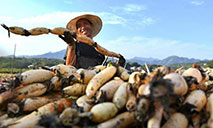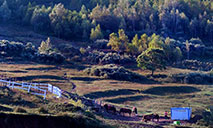Xinjiang lakeside ethnic village finds "fountain of life" in cultural tourism

Tourists take selfies at Tianchi scenic area in northwest China's Xinjiang Uygur Autonomous Region, April 25, 2020. (Xinhua/Sadat)
URUMQI, Sept. 26 (Xinhua) -- For 38-year-old Ani Bayatihan, autumn is one of her favorite seasons, as her village in northwest China's Xinjiang Uygur Autonomous Region takes on a variety of colors, attracting swarms of visitors.
Dressed in a light purple Kazakh ethnic costume, Ani is always full of passion when introducing her village to visitors, which she has done for 11 years.
Located at the foot of the Tianshan Mountains and near the world heritage site of Tianchi Lake, Kuokehula Village is a must-visit tourist destination in the scenic area.
Ani is a veteran tourist guide in the Kazakh ethnic village, which is also known as a folk custom cultural park in the lake area.
"I was nervous when I first faced tourists 11 years ago. My mandarin was not fluent at that time. I have become more confident and increasingly fond of my job over the years through exchanging with tourists from around the world," said Ani.
Like Ani's family, each of the village's 100-plus households has been taking a slice of the burgeoning tourism "cake." Villagers engage themselves in a variety of "occupations" in the park according to their own needs and specialties such as singing, dancing, making milk tea and barbecued meat and making handicrafts.
A tour around the park is like visiting an open-air museum of the Kazakh ethnic culture, with billboards introducing a string of folk customs and villagers practicing skills of making folk crafts such as traditional embroidery and staging performances.
"The village-turned folk cultural park is a great platform to display Kazakh culture and history," said Bai Yanling, head of the Tianchi tourism council. "It works for culture protection and promotion."
"You could get an immersive experience and a good knowledge of the Kazakh ethnic life before heading to the natural wonders in the mountains," said Xu Qin, a visitor with a tourist group from east China's Jiangxi Province.
Visitors can hardly imagine that just over a decade ago, local villagers lived a nomadic life.
In an effort to better protect the natural resources in the heritage site, the local government helped the villagers shift their living from herding and plowing tourism and catering services.
"The average household income in the village was over 10,000 yuan (about 1,548 dollars) a year from herding livestock. While, with the tourist development, most households now see annual income increase four times as much," said Wei Shuhua, head of the cultural tourism park.
After the autumn travel peak, Ani's village would soon see snow in November, when the park will be closed until next spring.
Villagers are no longer worried about the slack season since a nearby ski resort would offer plenty of jobs with a booming trend of winter sports in the country, said Ani.
Photos
Related Stories
- Int'l cultural expo, tourism festival on Silk Road held in NW China
- Int'l cultural expo, tourism festival on Silk Road open in NW China
- China's tourism industry sees strong post-pandemic recovery
- China to hold culture, tourism expo in Wuhan
- Village in Nanjing, east China embraces prosperity through development of homestay tourism industry
Copyright © 2021 People's Daily Online. All Rights Reserved.










